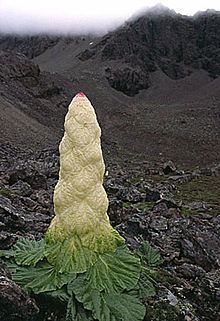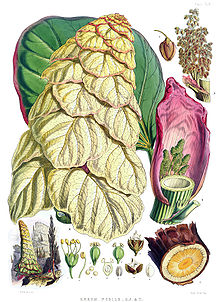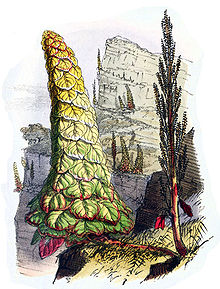- Rheum nobile
-
Noble rhubarb 
Scientific classification Kingdom: Plantae (unranked): Angiosperms (unranked): Eudicots (unranked): Core eudicots Order: Caryophyllales Family: Polygonaceae Genus: Rheum Species: R. nobile Binomial name Rheum nobile
Hook.f. & ThomsonRheum nobile, the Noble rhubarb or Sikkim rhubarb, is a giant herbaceous plant native to the Himalaya, from northeastern Afghanistan, east through northern Pakistan and India, Nepal, Sikkim (in India), Bhutan, and Tibet to Myanmar, occurring in the alpine zone at 4000-4800 meters altitude [1].
It is an extraordinary species of rhubarb (genus Rheum). At 1-2 m tall, R. nobile towers above all the shrubs and low herbs in its habitat, and it is visible across valleys a mile away.[2]
R. nobile is often called a glasshouse plant because of its outer curtain of translucent bracts which pass visible light, creating a greenhouse effect, while blocking ultraviolet radiation. These are important defenses against the increased UV-B exposure and extreme cold in its high altitude range [3].
Contents
Structure
An individual R. nobile is a conical tower of delicate, straw-colored, shining, translucent, regularly overlapping bracts; the higher ones have pink edges. Large, glossy, green radicle leaves, with red petioles and nerves, form a broad base to the plant. Turning up the bracts reveals membranous, fragile, pink stipules. Within these are short branched panicles of diminutive green flowers [4].
The root is often 1-2 m (3-7 feet) long and as thick as an arm, and bright yellow inside. The stems are pleasantly acidic, and they are consumed by the local people, who call the plant Chuka. The hollow of the stem contains a good deal of limpid water. After flowering, the stem lengthens and the bracts separate one from another, turning a coarse red-brown. As the fruit ripens, the bracts fall away, leaving a ragged-looking stem covered with panicles of deep brown pendulous fruits. As Hooker put their appearance: "In the winter, these naked black stems, projecting from the beetling cliffs, or towering above the snow, are in dismal keeping with the surrounding desolation of that season." [4].
Bracts
The bracts of R. nobile are 110-170 µm thick and do not differentiate into palisade and spongy layers.[5] They selectively block ultraviolet radiation while letting almost all visible light through; thus the developing flowers and the apical meristem are protected from the intense radiation found in high altitudes. The major UV blockers found in the bracts are all quercetin flavonoids: [6]
- Rutin, quercetin 3-O-rutinoside: widespread in higher plants and previously reported in leaves and petioles of other Rheum species
- Guaijaverin, quercetin 3-O-arabinoside: first report in Rheum
- Hyperin, quercetin 3-O-galactoside: widespread in plants and previously reported in leaves and petioles of R. rhaponticum
- Isoquercitrin, quercetin 3-O-glucoside: widespread in plants and previously reported in leaves and petioles of R. rhaponticum
- Quercetin 3-O-[6″-(3-hydroxy-3-methylglutaroyl)-glucoside]: first finding in nature
Minor UV blockers include quercetin 7-O-glycoside, quercetin itself, kaempferol glycoside, and feruloyl ester.
History
A description of R. nobile was first published by Joseph Dalton Hooker and Thomas Thomson in 1855. Hooker wrote:
- "The present is certainly the most striking of the many fine alpine plants of Sikkim; and though in every botanical character, as also in the acid juice of the stem, a genuine Rhubarb, it differs so remarkably in habit and general appearance from any of its congeners, that at first sight it could not be recognized as one of them. I first saw it from a distance of fully a mile, dotting the black cliffs of the Lachen valley at 14,000 feet [4,200 m] elevation, in inaccessible situations, and was quite at a loss to conceive what it could be; not was it till I had turned back the curious bracteal leaves and examined the flowers that I was persuaded of its being a true Rhubarb."[4]
References
- Hooker, Joseph Dalton; J. F. Cathcart and W. H. Fitch (1855). Illustrations of Himalayan plants. London: L. Reeve. pp. 93–95. LCCN 05-024640. http://www.illustratedgarden.org/mobot/rarebooks/page.asp?relation=QK34933H661855&identifier=0036.
- T. Iwashina and 5 others (April 2004). "Flavonoids in translucent bracts of the Himalayan Rheum nobile (Polygonaceae) as ultraviolet shields". Journal of Plant Research 117 (2): 101–107. doi:10.1007/s10265-003-0134-2. http://www.springerlink.com/openurl.asp?genre=article&eissn=1618-0860&volume=117&issue=2&spage=101.
- Tsukaya, Hirokazu (February 2002). "Optical and anatomical characteristics of bracts from the Chinese "glasshouse" plant, Rheum alexandrae Batalin (Polygonaceae), in Yunnan, China". Journal of Plant Research 115 (1): 59–63. doi:10.1007/s102650200009. http://www.springerlink.com/openurl.asp?genre=article&eissn=1618-0860&volume=115&issue=1&spage=59.
Notes
- ^ "Rheum nobile". Flora of China. eFloras.org. http://www.efloras.org/florataxon.aspx?flora_id=2&taxon_id=242343391. Retrieved 2006-06-11.
- ^ G.S. Rawat and E.D. Wikramanayake (2001). "Eastern Himalayan alpine shrub and meadows (PA1003)". Terrestrial Ecoregions. World Wildlife Fund. http://www.worldwildlife.org/wildworld/profiles/terrestrial/pa/pa1003_full.html.
- ^ Iwashina et al. p.101
- ^ a b c Hooker p.94
- ^ Tsukaya pp.60-61
- ^ Iwashina et al. 104-106
External links
Categories:- Polygonaceae
- Flora of Tibet
- Flora of Burma
- Flora of India
- Flora of Bhutan
- Flora of Nepal
- Flora of Pakistan
Wikimedia Foundation. 2010.


